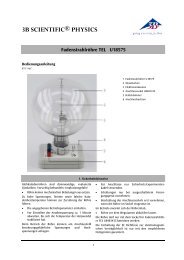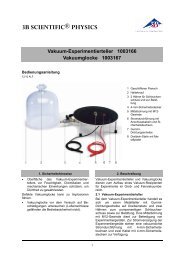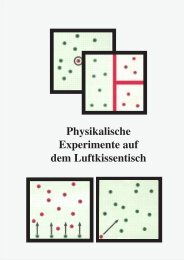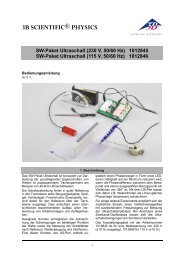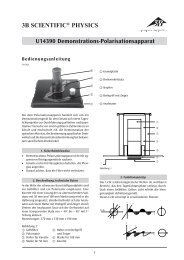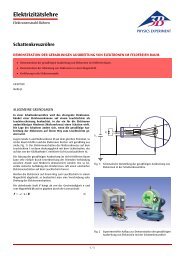3B SCIENTIFIC® PHYSICS Wellenwanne U21910
3B SCIENTIFIC® PHYSICS Wellenwanne U21910
3B SCIENTIFIC® PHYSICS Wellenwanne U21910
You also want an ePaper? Increase the reach of your titles
YUMPU automatically turns print PDFs into web optimized ePapers that Google loves.
4.6 Refraction of a linear wave at a combination<br />
of lenses<br />
• Place the biconvex lens in front of the<br />
biconcave lens<br />
• Proceed as in Experiment 4.3<br />
• Finely adjust until it can clearly be seen<br />
that linear wavefronts are once more<br />
visible beyond the second lens<br />
4.7 Refraction of a linear wave at a prism<br />
• Replace the lenses with prisms (as in<br />
the photographs)<br />
• Proceed as in preceding experiments<br />
• Changes in the direction of propagation<br />
of the wavefronts should be clearly visible<br />
• Close observation should reveal that all<br />
the wave properties of reflection, refraction<br />
and also Huygen's principle can<br />
be made apparent<br />
5. Refraction of linear waves<br />
5.1 Refraction at an edge<br />
• Place the glass block right in front of<br />
the exciter (see photograph)<br />
• Finely adjust frequency and amplitude<br />
until the propagation in the obstructed<br />
region is clearly visible (refraction refers<br />
to divergence from linear propagation)<br />
5.2 Refraction at a single slit (wavelengths<br />
greater than/smaller than the width of<br />
the slit)<br />
• Place the obstruction with the wide slit<br />
parallel in front of the linear exciter<br />
• Use the wide slit adjusters to set a<br />
width between 1 and 2 cm<br />
• Make fine adjustments till the resulting<br />
waves are clearly visible (showing propagation<br />
in the obstructed region)<br />
8



